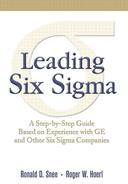Reward and Recognition Plan
As noted in Chapter 4, we believe that the most effective motivation is intrinsic motivation; i.e., people doing something because they believe in it or want to do it. For example, throughout history mercenary armies have never performed well against armies that believed in what they were fighting for. On the other hand, if there are no tangible rewards for accomplishments in Six Sigma, this omission will essentially be a de-motivator. People may say: “I would love to be involved in Six Sigma, but I'm concerned about what it might do to my career.”
We must balance intrinsic motivation with extrinsic motivation. Extrinsic motivation means providing a carrot or stick to motivate someone to do something they would not do otherwise, such as rewarding children for cleaning their rooms. Providing extrinsic motivation will help ensure that there are no barriers to our top talent getting involved in Six Sigma.
We are all motivated to work on those things that will be beneficial to our career. This fact leads us to consider what reward and recognition system we will use to support Six Sigma. In fact, some companies have the reward and recognition plan for Six Sigma designed prior to deployment. Jack Welch comments that at GE: “As with every initiative, we backed Six Sigma up with our rewards system” (Welch [2001]). This included 40% of the annual managerial bonus based on Six Sigma results, stock option grants for Black Belts and MBBs, and Green Belt certification being required for promotion.
Every successful implementation of Six Sigma we are familiar with has developed a special reward and recognition system to support Six Sigma.
Conversely, during previous improvement initiatives (such as TQM) leadership may have stated that they wanted one behavior (e.g., quality improvement), but rewarded something totally different (e.g., making the financial numbers). Such disconnects between leadership's words and actions are immediately obvious to employees, and can lead to cynicism. The reward and recognition system is a statement by leadership about what it values and is a much more important document than a printed values statement. Leaders must think carefully about the message they want to convey.
Like communications, the form of the reward and recognition plan is greatly dependent on the culture and existing plan of the company involved. Some companies choose to use their existing system, as they feel it has the capability to adequately reward the contributions of those involved in Six Sigma. This may be the case in some instances, but in general a special reward and recognition system should be developed. The following list summarizes the Black Belt recognition program for one company we have worked with. This plan recognizes that Black Belts are critical to our success, and special rewards are needed to ensure that top performers are anxious to take this role. Unfortunately, this plan makes no mention of rewarding others involved in Six Sigma work.
Base Pay
Potential increase at time of selection
Retain current salary grade
Normal group performance review and merit pay
Incentive Compensation
Special plan for Black Belts
Target award at 15% of base pay
Performance rating on 0 - 150% of scale
Measured against key project objectives
Participation ends at end of Black Belt assignment
The Six Sigma reward and recognition plan for another company is summarized in the next list. Note the completeness of this plan, including recognition of Green Belts and team members (including MBBs and Champions), and an annual celebration event complete with leadership participation.
BB Project Completion
$500 to $5,000 in cash or stock options for first project
Plaque with project name engraved for first and subsequent projects
BB Six Sigma Activity Awards
Recognizes efforts and achievements during projects with individual and team awards—Cash, tickets, dinners, shirts, etc.
Green Belt Recognition
Similar to Black Belt recognition
No certification bonus
Project Team Member Recognition
Similar to BB and GB recognition
No certification awards
Annual Six Sigma Celebration Event
Presentation of key projects
Dinner reception with senior leadership
Note also that all rewards do not have to be monetary. For many people peer and management recognition, such as an opportunity to present their project, is a greater reward than money.
In evaluating these reward and recognition plans, and those of other organizations, we conclude that the most appropriate plan is company dependent. What works for one company, or even one employee, will not necessarily work for another. Reward and recognition plans are also not static. The points listed on pages 119 and 120 will likely change over time as experience with Six Sigma grows, and the reward and recognition needs become clear. The one constant is to make sure you are rewarding the behavior you want to encourage.
Six Sigma goals and objectives should be part of performance plans for all those involved in the Six Sigma initiative. If the company intends for Six Sigma to involve the entire organization, then these goals and objectives must be included in the performance plans for the entire organization. This is consistent with our earlier recognition that we are all motivated to work on those things that will be beneficial to our career. Six Sigma responsibilities should be part of people's individual goals and objectives, and their performance should be evaluated relative to these goals and objectives. Once again, what we measure and pay attention to gets done.
